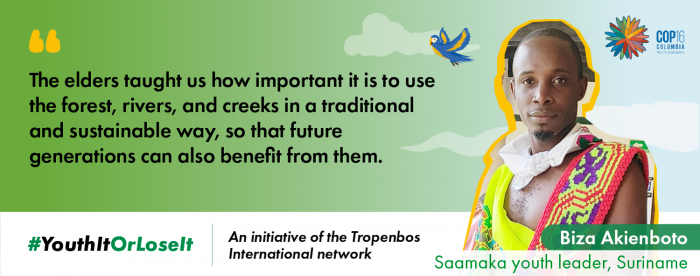News
Our stories ... ...

the Netherlands - 03 October, 2024
Biza Akienboto is a Saamaka youth leader from Suriname and also one of the grassroots of the VSG (Association of Saamaka Traditional Communities) youth group, where young people are strengthened in good governance.
Biza is a strong advocate for the Saamaka case and a good representative of its people who knows its traditions and culture very well. He is also part of the trajectory towards land rights issues by making others aware of the importance of their rights. Preserving the culture and tradition with its biodiversity is a serious topic he wants to discuss and transfer back to the community he works with.
Biza will be part of the COP 16 Event: Youth it or lose it! Traditional knowledge transmission for the sustainable use and conservation of biodiversity this October, 24th in Cali, Colombia. Get to know him through this interview.
Since 2015, I have been working on community development projects in the Upper Suriname area through the organization Botopasi Youth Development Foundation. Personally, I believe and work from the love I have for my Saamaka community. The motivation to become a youth leader is a personal choice, because I feel passionate about contributing to the development of my Saamaka community.
Some of the projects aimed at the youth are education about HIV, alcohol, and drugs, a school packages project to support families within six villages near Botopasi, and a Miss Hanse Koosu (beautiful traditional clothes) contest, where traditional knowledge sharing was one of the goals.
The elders taught us how important it is to use the forest, rivers, and creeks in a traditional and sustainable way, so that future generations can also benefit from them. We hunt and fish the amount that we consume because overfishing and hunting without a bag limit can lead to loss of fauna and biodiversity. We also do not unnecessarily cut wood or engage in logging activities but extract the amount we need. Our forest with undisturbed biodiversity, serves as a natural pharmacy and is our home where we grow old in peace.
The main environmental challenges we are facing in the Saamaka community are:
Forest degradation because of uncontrolled mining and logging activities, leading to habitat and biodiversity loss
Pollution of soil and water due to uncontrolled mercury and cyanide use in the mining industry
Everyone must be aware of unusual activities within our area and responsible for monitoring. We have unwritten rules and regulations which we are all aware of as a community. We grew up with these rules and regulations as traditional knowledge, and as part of our culture, we should obey them. If any form of harm or unusual activities are detected, this is reported to the traditional authority right away so we can come up with a collective solution. We can only keep a balanced ecosystem by protecting our forest if we work together to monitor it.
Why do you think it is important to share your story about your relationship with biodiversity and the ancestral knowledge of the elders in your community at an event like COP16?
It is important to share my story because I want the world to know that the sustainable way our ancestors have lived with the forest, creeks, and rivers and which has been handed over to us, is in danger. Modern development and the lack of Free, Prior and Informed Consent (FPIC) of external actors threaten our traditional knowledge, which will affect our biodiversity, certain ecosystems, us as a community, and the whole world. We should all care for mother nature to keep the balance of the climate, ecosystems and biodiversity. This will also benefit us and the next generations. Sharing insights and stories from all over the world with each other is building and keeping together a team with the same visions and goals. It will give us an opportunity to learn from each other about different ways we in Suriname can protect the 1.4 million hectares of tropical rainforest that we call home.
My recommendation is that organizations strengthen young people with resources to empower their communities by assisting and guiding them with the writing of project proposals for different environmental, biodiversity and climate change related projects. Also, guidance with resource mobilization, which can help capture many other activities involved and for managing sustainable projects for Saamaka communities